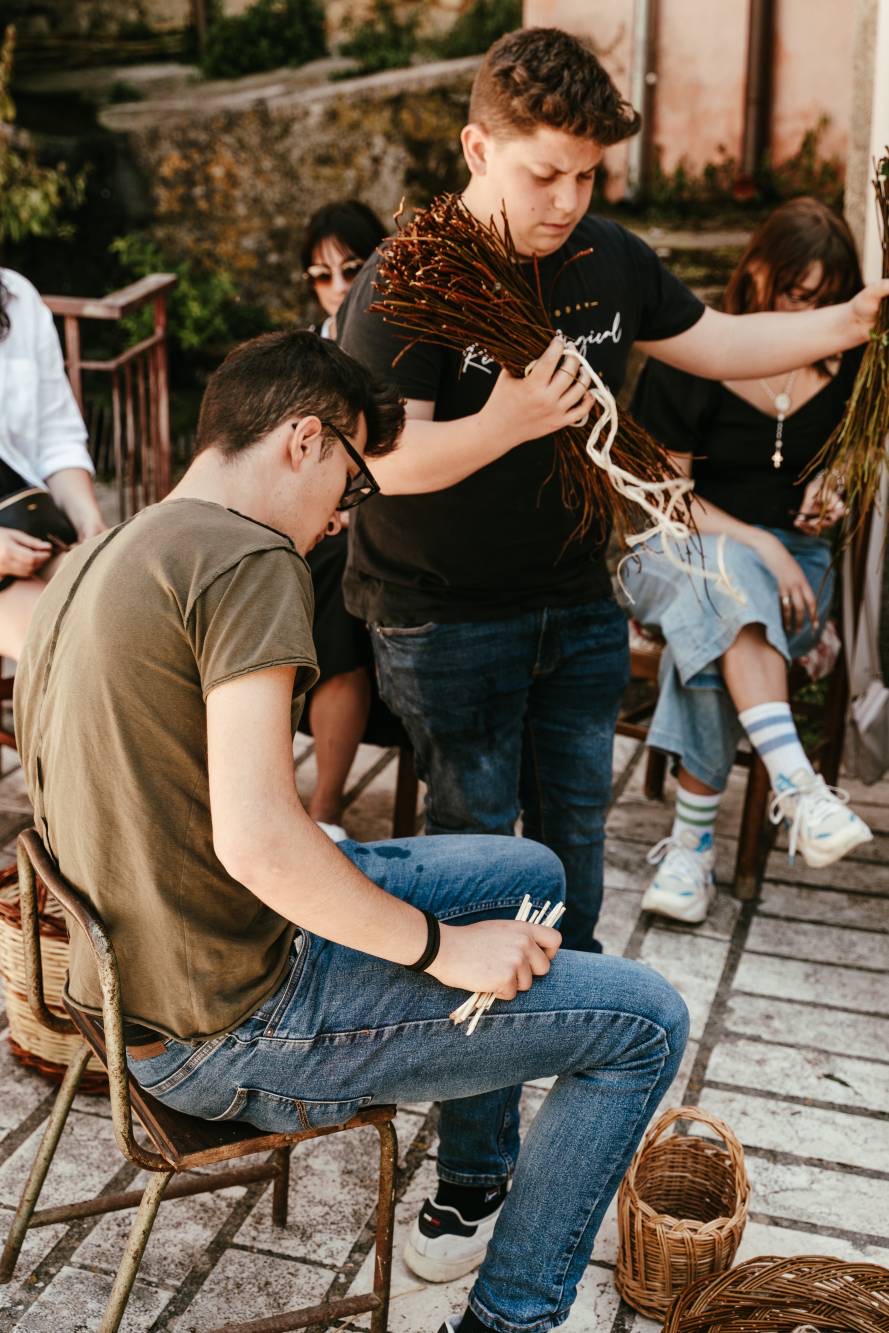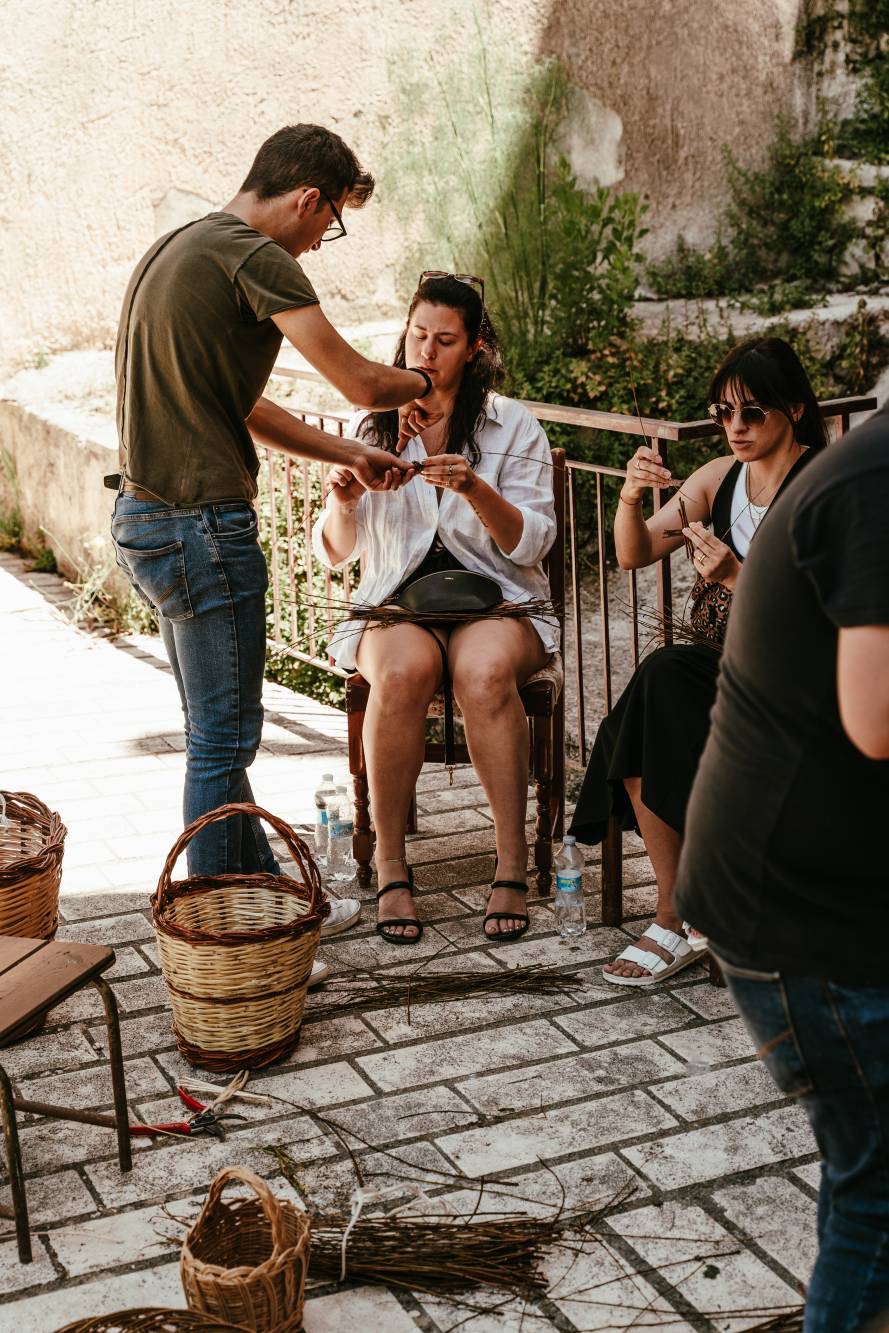Ancestral Art: basket making in Sicilia
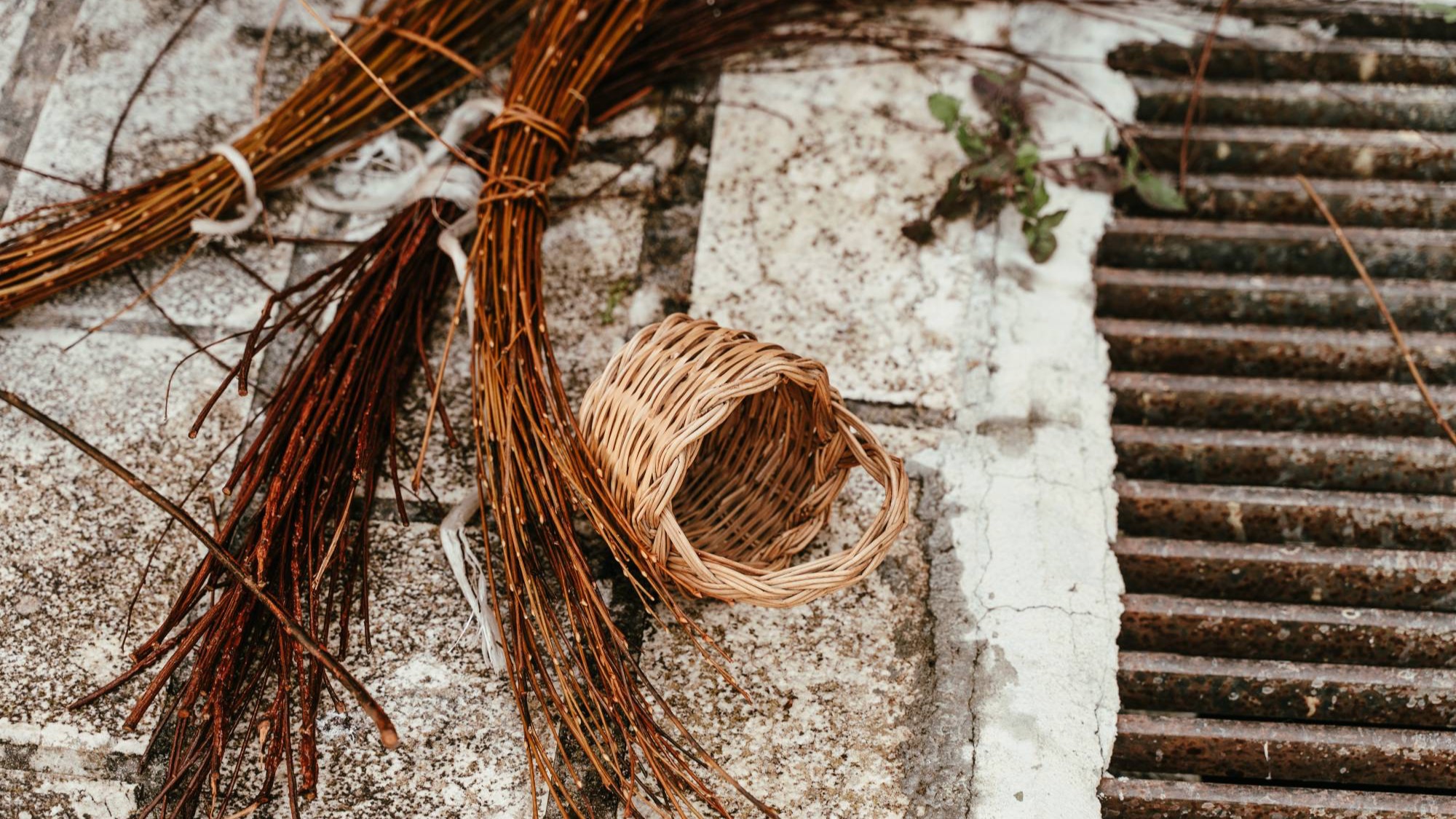
We arrived in Isnello, Sicily, a small village in the Madonie Park, after a long and treacherous drive through the S- turn after S- turn mountain roads in a large van.
Though Isnello is both in the same province and mountain range as where we were staying— in Petralia Sottana— the drive is… well as one person said as they stepped out of the van “that was absolutely horrible”. :)
It was also a hot day, temperatures in the 90s, and the Mediterranean sun can be relentless, with no place for refuge. The absent of large shade trees, especially in villages, added to the heat. This discomfort, though not sought out, is oftentimes part of our being together on ancestral land. We don’t actually come for comfort. We come to grow and find the utter magic in the discomfort.
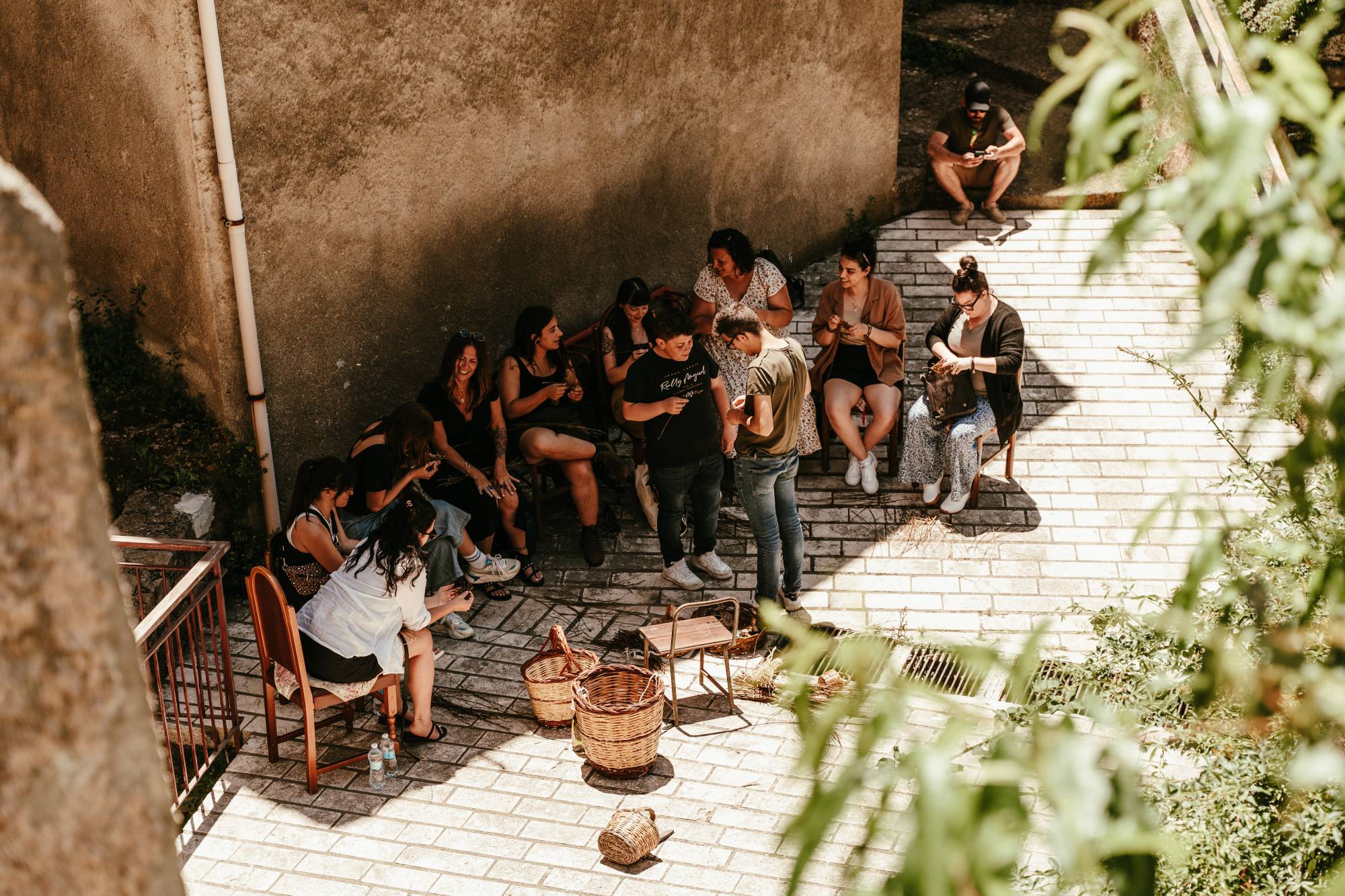
We walk along the village streets, gather more water at the local market to gulp, and take in the view of this village, Isnello. It’s situated so high in these mountains, and the sky is wide open — a direct connection from the stone tiled streets to the scorching, white-yellow sun. We were up there, and we were wide open and vulnerable, not just from the drive, or the sun, but we had landed here, and we were about to weave, something most of us had never done before. As we walked, we notice that along the street there are small signs of planetary information- a sign for Venus, for Jupiter, for Mars. Being this high up, and with such open sky, one can only imagine the visibility up here (Isnello is the home to the Gal Hassin Osservatorio Astronomico). We could only imagine what the night must look like for those living her — how close the stars and planets must feel, like they could be touched if you reach up your arm.
We find our way down some steep stairs and land in a back alley, or maybe more aptly described as a simple, hidden courtyard. It was a public place, for sure, but one that you could tell had been taken over regularly for making baskets.
Chairs were set up for us in a semi-circle, piles of thin branches were in the center of the chairs, and the basket maker and his cugino were there waiting for us.
Emanuele Pallaro, the basket maker who we will work with, is 18 years old, dark hair and eyes, wearing the typical skinny jeans with a low rise that they boys wear here in the south. His cousin, Angelo, probably about 15 years old, will be with him, assisting him in helping a group of Italian American ladies find their inner-weave magic. We find out later, Angelo isn’t a blood cousin to Emanuele, even though that is what they called each other — but they are close like cousins, like cummari with women, these boys are cumpari to each other – male friendships of true depth and meaning. The kind that share importance, a whole life, connected.
Typically when we make baskets, the people who are showing us are elders, and always male elders. This time we chose Emanuele, in some ways to transfer the energy to us that we can keep tradition alive, we can pass what we learn on. Emanuele is an example — he has his whole life to live weaving baskets and keeping the craft alive and well in his village. I was curious what it would do to our ancestral re-membering, to how we might look at how we can carry on tradition — by witnessing not an elder close to the end, but instead a young man holding the tradition in youthful hands.
We talk about how these arts are dying, but seeing this, and learning from two village teenagers, brought a hope to my entire body. We often see the older folks worried about “who will carry this on” —and then here we are, landing in a spot, where here, in the middle of an ancient village, deep in the mountains, and see two teenagers doing exactly that, answering the hopeless question so many of us have. I think it was worth the drive, the car sickness, the heat. To be present to those who embody what we grieve, what we have lost: and re-membering it in ourselves as well.
…
The art of weaving is a practice of all of our collective history and ancient, ancestral traditions. Little bits of baskets have been found in the Egyptian pyramids. Impressions have been found inside ancient pottery. Baskets and weaving are a part of being a human, on earth.
Ancient Mesopotamians believe that baskets are actually the offsprings of the gods, that they are one of the main foundations of the creation of our land/earth. Their ancient creation story says that land was formed by weavings— they believed that the gods placed woven wicker rafts on the waters, and on these wicker “basket/rafts” the gods placed clay or soil and from that matter our land masses were created.
As soon as humans were able to weave fibers together, they began experimenting. Creating structures for woven containers. Baskets were needed for everything imaginable- food, clothing, seeds, storage and transport. They represented abundance - because if they needed baskets, that meant they had food to fill them. That means they were living — growing, connecting, sharing, storing, gathering. Weaving also took place in creating shelters, places to dwell.
As the explorers and colonizers arrived, they traded their goods. The goods were contained in baskets- and so these baskets traveled across lands and cultures, with the hands of many people woven within them. With the humans, the baskets traveled and covered vast ground. Different styles and techniques were shared and traded along with the goods that they held. This explains why so many Asian techniques- like hexagonal weaves- are found in European baskets, and how European techniques were then carried over to the Americas, eventually, and one style mixed with another and another and another. All weavings have been brought together, wherever humans have meet — good, bad, or however, the way we wove has been a co-creation.
Just like DNA has been woven and woven. Our languages. Our flavors. Our ways. Our saints. Our gods. Our cultures. Our beliefs.
Basket weaving in Sicily is one of their most important ancient arts, an ancestral art that is complex and yet simple. Beautiful and yet functional. Weaving combines artistic ability with the knowledge and wisdom of ancient techniques people have learned since childhood and then handed down from generation to generation. Most basketweavers on the island today learned from their parents or grandparents and so on and so forth.
Materials that are used: Olive twigs, reeds, willow, elm, wicker and scotch brooms are the most used weaving materials in this Sicilian rural tradition. Pliers, scissors, knife and awl are tools used by traditional makers. Baskets such as u Panaru, a particular Sicilian basket - that we made together with basket maker Emanuele Pollara of Isnello, - is typically made of wicker/willow and cane.
In Sicily, every basket made by hand has a characteristic name in dialect, such as cufinedda, cartedde, cannizzi, (you can impress the basketmaker by asking him about these names:) There are also many traditional objects which can be made through the art of weaving, such as chairs, tools, hats, bags and various containers— such as molds for cheeses.
…
We sat together and wove. Let me tell you, it wasn’t easy, it didn’t go as smoothly as most of had hoped. But we learned, and we practice. Emanuele and Angelo were patient with us, oftentimes they had to take my basket straight out of my hands and un-weave all my mistakes for me so I could re-weave it well. But the point was not to make a perfect basket.
Who does anything perfect the first time you try something? Who does anything perfect the fifth time? Or ever?
We came together to weave baskets high in the mountains so that we could be “not good” at something, and at the same time awaken this movement, this rhythm, this heat, this elevation within our bodies. We can talk and talk about ancestral reclamation or connection all we want. But what does it look like? How about sweating, being uncomfortable, laughing, loving, hanging outside in an ancient village, desperately trying to get a weave to work, and knowing it’s probably not right, while being taught by a multi-generational basketmaker, whose passion is to carry on this ancient tradition? The act of just doing, integrates all the talk in our bodies. Not to mention the redistribution of energy in this little village barely anyone knows about. We come and exchange — not only money, but time, interest, our ancestors all come together and say “thank you” — and we try to weave the wisdom stuck in our cells back into place again.
…
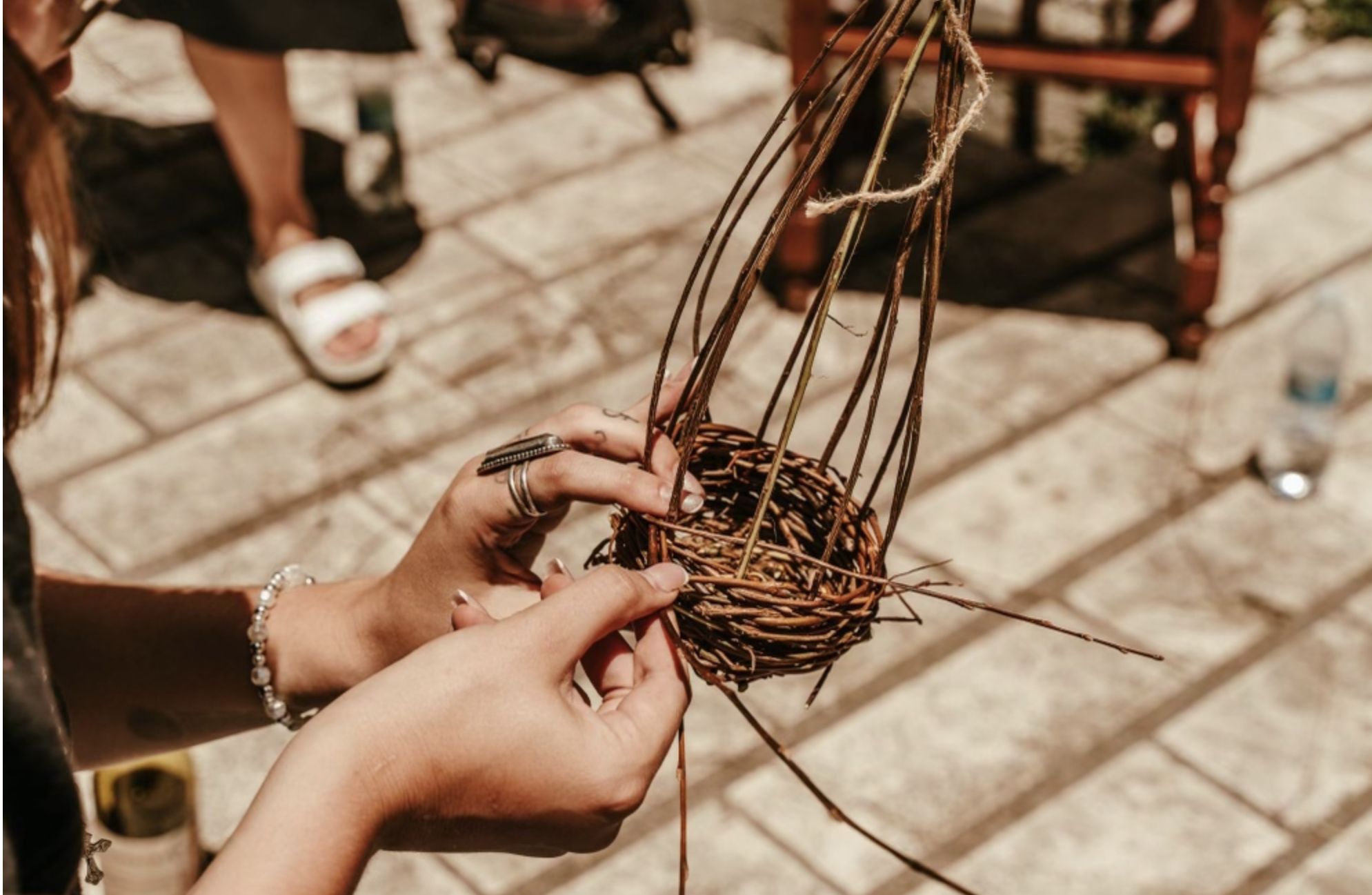
I think of basket weaving as such a ritualistic symbol of our ancestral work — we are weaving together the past, the present, the future. We are weaving together all our lineages and cultures. And weaving a basket to hold all our new wisdom, tools, teachings, magic that we have received. And a place to store what we want to generously share with others.
We are here together because of the weaving of your ancestors, my ancestors, and the ancestors of the people we visit and learn from. If you have ever read Robin Wall Kimmerer’s “Braiding Sweetgrass” which is her story of the weaving of her own culture (Potawatomi)- Sicilian basket weaving is similar in concept. The baskets weave the season, because what material is used depends on the time of year. It includes the long history of all those who have been on the island, the styles are a mix of who contributed to the culture. It weaves the generations of who have held the traditions. And now, it weaves us.
…
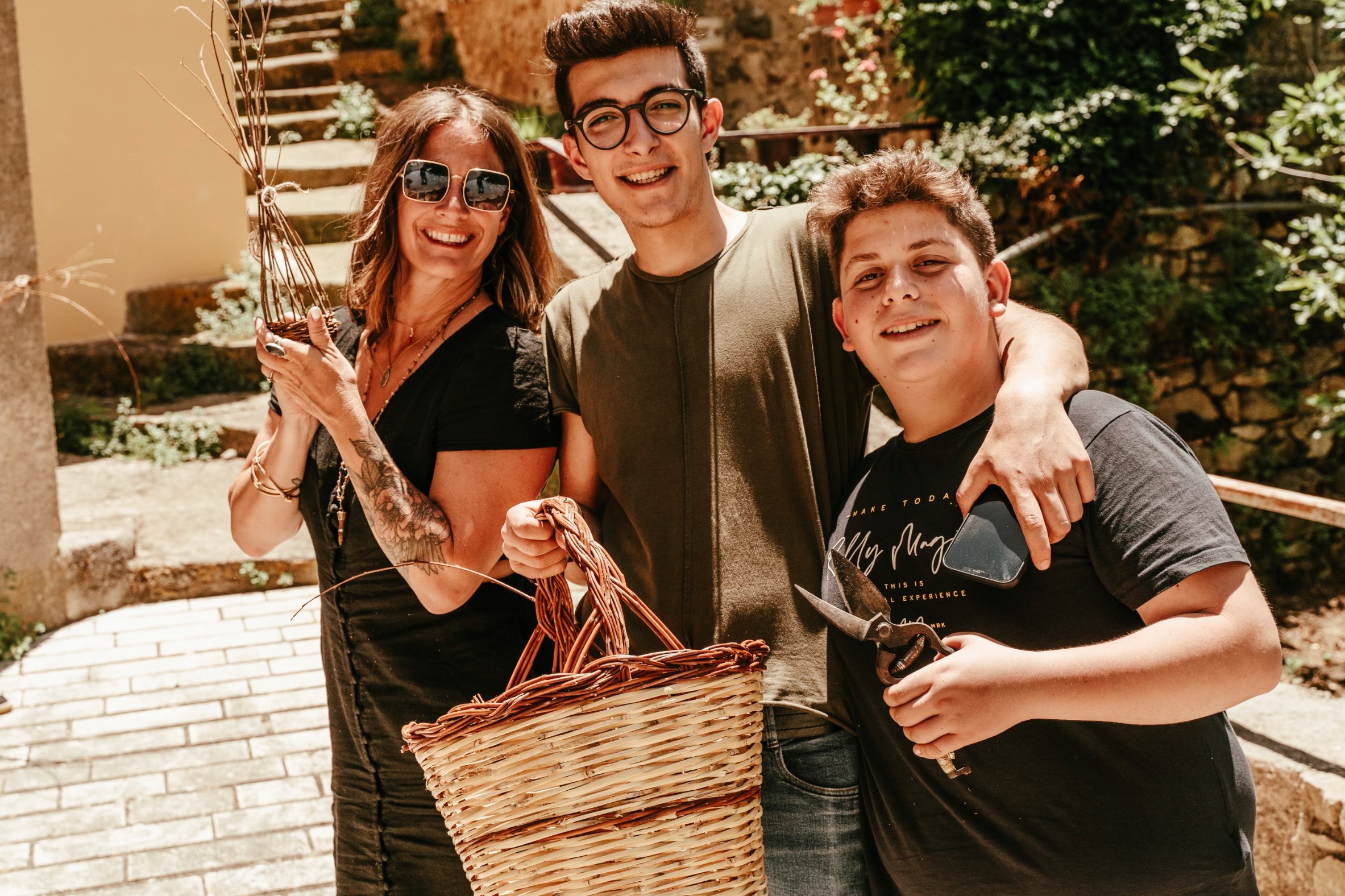
I had the opportunity and honor to talk with Emanuele and ask him a few simple questions so we can understand how and why he was passed on this tradition, and the reason he is so serious about keeping it alive.
Radici: How old are you?
Emanuele: 18 years old
Radici: How did you come to start making baskets?
Emanuele: I learned the art from my uncle, who was the last living basketmaker in Isnello.
Radici: Tell me why you are so passionate about keeping this tradition alive
Emanuele: One reason is that my dear uncle passed this skill on to me, he handed it to me, and after he died I did not want him to be forgotten, so I took up his art in a real way, I began weaving to continue in his footsteps
Radici: Tell me more about why basket weaving is important culturally.
Emanuele: It’s very important for me personally not to lose this tradition, but it is also important for Sicilian culture because before the arrival of plastics, the basket makers were the ones who weaved the containers for all things- especially the food, the vegetables in the gardens, for the harvest of olives and grapes. These baskets were placed on the shoulders of donkeys, and inside them they carried various things people needed transported to different areas. The baskets range from large baskets used for wood transportation, and the smallest used for fruits or mushrooms.
Radici: What materials do you use for baskets?
Emanuele: The most used materials are wild willow, wild olive, and river reeds.
Radici: What is your favorite style of basket to make
Emanuele: I like making fruit baskets.
Radici: Tell me what a person so young would be so interested in this?
Emanuele: It’s really nice for me to express my creativity. Also, it’s a good pastime. Instead of always being on the phone doing nothing, on social media, I sit and weave baskets.
… About Isnello, Sicilia / isneddu (sicilian)
About Isnello, Sicilia / isneddu (sicilian)
Isnello is a small village in the Madonie mountains that points to the stars, in the heart of the Madonie Park. It’s a small and charming village at the foot of a Byzantine castle, surrounded by the natural beauty of the Madonie Park, with the Montagna Grande resting in the background. The village’s history dates back to the Neolithic period. Because of the various dominations over time - the artistic and architectural heritage is of great value. It has a layout of tiny alleys and squares, panoramic viewpoints, palaces and places of worship, that all spirals around the early medieval castle. Built as a lookout point it became part of the island’s defensive system—useful in surveillance, defense of the territory, and also a residence for the troops of the Royal Court. From the end of the twelfth century to part of the fifteenth, its history is intertwined with that of the noble families living there and who transformed the town from a military outpost to noble headquarters. Sources report that the name during the period relating to Arab domination, was Menzil Al-Hamàr or fortified village; evident traces of this fortress have remained in the urban layout. The name Isnello derives from the characteristics of the watercourse that crosses the whole territory. The name originates from the Syriac "hassin" which means cold river, or from the Punic "hassinor" which indicates a stream that flows in a tube-shaped bed, or from the Greek "asines" which indicates the harmlessness of the stream.


